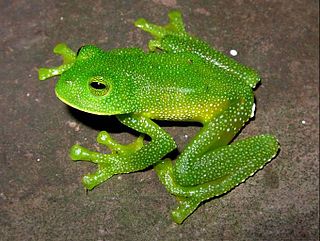Centrolene acanthidiocephalum, commonly known as the Santander giant glass frog, is a species of frog in the family Centrolenidae. Its current placement within the subfamily Centroleninae is uncertain. It is endemic to Colombia where it is only known from the region of the type locality on the western slope of the Cordillera Oriental in the Santander Department, at the elevations of 1,750–2,100 m (5,740–6,890 ft) asl.
Centrolene altitudinalis is a species of frog in the family Centrolenidae. It is endemic to Venezuela. Its natural habitats are subtropical or tropical moist montane forests and rivers. Its status is insufficiently known.

Centrolene antioquiensis, commonly known as the Antioquia giant glass frog, is a species of frog in the family Centrolenidae that is endemic to Colombia. Water pollution from agriculture, and more locally deforestation, threatens this species.
Espadarana audax is a species of frog in the family Centrolenidae. It is found on the Amazonian versant of Andes in northeast Peru, eastern Ecuador, and southern Colombia.
Centroleneazulae is a species of frog in the family Centrolenidae. It is threatened by habitat loss, and is enlisted in the IUCN red list.
Centrolene hesperia is a species of frog in the family Centrolenidae. It is endemic to Peru. Its natural habitats are subtropical or tropical moist montane forests and rivers. It is threatened by habitat loss.
Centrolene huilensis is a species of frog in the family Centrolenidae. It is endemic to Colombia and only known from the region of its type locality near Isnos, on the Cordillera Central in the Huila Department.
Centrolene hybrida is a species of frog in the family Centrolenidae. It is endemic to Colombia. Its natural habitats are subtropical or tropical moist montane forests and rivers. It is not considered threatened by the IUCN.
Centrolene lemniscata is a species of frog in the family Centrolenidae. It is endemic to Peru. Its natural habitats are subtropical or tropical moist montane forests and rivers. Its status is insufficiently known.
"Centrolene" medemi is a species of frog in the family Centrolenidae. The species occurs in the Cordillera Oriental in the Tolima, Caquetá, and Putumayo Departments in Colombia and adjacent Napo in Ecuador. The generic placement of this species within the subfamily Centroleninae is uncertain. The specific name medemi honors Fred Medem, collector of the holotype. Common name Medem giant glass frog has been coined for it.
Centrolene notosticta is a species of frog in the family Centrolenidae. It is found on the Cordillera Oriental in Colombia and on its extension to north, Serranía del Perijá, in the Zulia state in Venezuela.

Centrolene paezorum is a species of frog in the family Centrolenidae. It is endemic to Colombia. Its natural habitats are subtropical or tropical moist montane forests and rivers.
"Centrolene" petrophilum is a species of frog in the family Centrolenidae. Also called the Boyaca Giant Glass Frog.
Centrolene pipilata, commonly known as the Amazon giant glass frog, is a species of frog in the family Centrolenidae. It is endemic to Ecuador. Its natural habitats are subtropical or tropical moist montane forests and rivers. It is threatened by habitat loss.

"Centrolene" robledoi" is a species of frog in the family Centrolenidae. It is endemic to Colombia. Its natural habitats are subtropical or tropical moist lowland forests, subtropical or tropical moist montane forests, and rivers. It is threatened by habitat loss.
Centrolene sanchezi is a species of frog in the family Centrolenidae. It is found in the Andes mountains in Colombia and Ecuador. Its natural habitats are subtropical or tropical moist montane forests and rivers.
Centrolene venezuelensis is a species of frog in the family Centrolenidae. It is endemic to Venezuela and known from the Venezuelan Andes and from the Serranía del Perijá, Zulia state. In Spanish it is known as ranita de cristal Venezolana or ranita verde de labio blanco.
Centrolene daidalea is a species of frog in the family Centrolenidae. It is known from Colombia and Venezuela.
Centrolene solitaria is a species of frog in the family Centrolenidae. Known only from its type locality in Florencia, Caquetá, it is endemic to Colombia.

Centrolene savagei is a species of frog in the family Centrolenidae that is endemic to the Andes of western Colombia, specifically the Cordillera Occidental and Cordillera Central. Its common name is Savage's Cochran frog.





